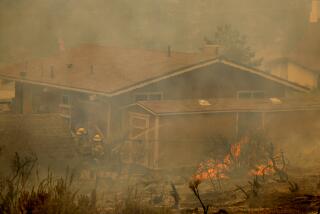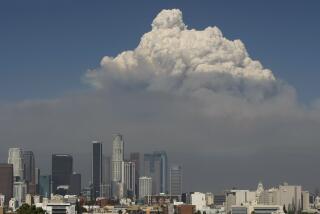Fighting fire with flora
Jeff Powers had a front-row seat for the fire that destroyed 441 structures as it raged through the romantic hillside community of Laguna Beach in 1993. By the time it ended, his personal belongings were easy to tally: the clothes he was wearing, two left shoes, one dog, one cat and one basket of laundry.
Despite the loss of his home, Powers’ landscape survived relatively unscathed, standing up to temperatures in excess of 2,000 degrees. In fact, the landscape not only survived, but it also protected his wooden house from the fast-moving fire during its initial pass.
“I took off when 30-foot flames were 50 feet from my house,” Powers said, “but when the wall of flames hit my garden, it split and went around the property. I left believing my house would be all right.”
Four hours later, in a hotel room a few miles away, Powers sat in awe as he watched his house burn on TV.
“The wind had shifted and was showering my block with embers,” he recalled. “I’m sure it was slow to start, but once the deck caught, the house probably went quickly.”
Amazingly, the garden survived this second fire too. “It was completely surreal,” Powers said. “Coming home to a garden that looked as healthy as ever, but seeing 24 inches of ash instead of my home was unnerving.”
Powers is as native to Southern California as the ironwoods in his garden, and he is used to fires. Since 1969, has lived in Laguna Beach, where fires are almost a yearly occurrence. As co-owner of Earthscaping, a landscape construction and maintenance company in Costa Mesa, he has been landscaping for fire protection for 20 years. Many of his clients live in fire-prone communities.
According to Powers, three characteristics work together to create a successful, fire-retardant landscape. First, he relies on a clear vision: He employs the Zone Theory, which advocates specific buffer zones of protection around a house. Second, his garden consists of mostly native plants, which have unique adaptations to fire. And perhaps most important, he maintains his landscape in a timely manner.
Powers uses the following calendar to guide his actions in the garden. It’s one anyone in Southern California can use because it works well with most Mediterranean landscapes.
Spring
Pruning is the dominant theme of spring, and Powers comes into his garden as if he were fire. “It is very important to bring that type of energy into a native landscape,” he said. However, he does not touch the annuals and perennials until they have set seed. “If you cut the plant before it produces seed, it will come back bigger, with more blooms. By letting a plant produce seed, it allows it to complete an important cycle. It allows it to rest.” After seed production he cuts his encelias, mimulus, lupines, artemisias and sages nearly to the ground.
At least once every two years the large lemonade berries (Rhus integrifolia) and oaks are thinned. He prunes these types of plants from the inside out. This involves first cutting the twiggy growth deep inside the tree, then the cross branches and at least one large branch to allow sun and wind to move through. “I can reduce fuels by more than half without sacrificing the plant’s ability to keep the soil cool, screen a view and provide habitat.”
Mustard, dandelions, annual grasses and morning glory (Ipomoea acuminata) are problems in Powers’ landscape. With a sigh, he says the absolute best way to get rid of unwanted weeds is to yank them. “It’s easy in spring because the soil is still moist. Weed whacking and chemicals really don’t work.”
Summer
Like the native plants, Powers takes the summer off. By restricting the use of water to the plants around his house, he keeps the plants on his hillside dormant, which is natural for natives in summer.
“Watering natives in summer is disastrous,” Powers said. “They become prone to rot, their roots will surface and it pulls a plant from dormancy,” creating greater fuels. His only real chore is to remove ignitable fuels, such as dried piles of leaves and twigs.
Fall
Statistically, fall is the most dangerous time of year for fires in Southern California. Powers knows this and, once again, comes into his garden as if he were fire. “Every year I cut a few Rhuses and ironwoods nearly to the ground. When the rains hit, they’ll crown, sprout and bounce right back. Having plants in different stages of growth helps make my landscape healthy,” he explained.
Using the rains as a signal, he then begins planting. When choosing plants, Powers is just as concerned about fire protection as he is about erosion control. “I pick plants that will help cool and slow a fire. I also look for varying rooting depths....These different layers of roots hold my hill together.” He favors coast live oaks. “I have seen them nearly stop a fire.”
Winter
The list of tasks is small during winter. Powers monitors the slope for erosion but doesn’t worry much. “The rains have pulled the entire landscape out of dormancy and the rapid growth protects the soil.” If anything, he prunes his Torrey pines. “Pruning when it’s cold and moist is best,” a time when “boring insects are least active.”
To some, Powers appears lighthearted when discussing the fire of Oct. 27, 1993, but maybe he has reason to be: “Hey, I didn’t lose anything living, and besides, the house took only 1 1/2 years to rebuild. The garden would have taken 20.”
More to Read
Sign up for Essential California
The most important California stories and recommendations in your inbox every morning.
You may occasionally receive promotional content from the Los Angeles Times.










